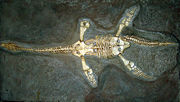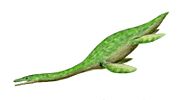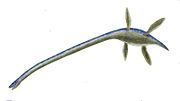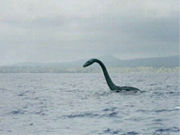Plesiosaur
2008/9 Schools Wikipedia Selection. Related subjects: Dinosaurs
| Plesiosaur Fossil range: Early Jurassic - Late Cretaceous |
||||||||||||
|---|---|---|---|---|---|---|---|---|---|---|---|---|
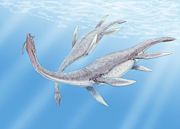 Plesiosaurus.
|
||||||||||||
| Scientific classification | ||||||||||||
|
||||||||||||
| Families | ||||||||||||
|
† Cimoliasauridae |
Plesiosaurs (pronounced /ˈpliːsɪəˌsɔr/) (Greek: plesios meaning 'near' or 'close to' and sauros meaning 'lizard') were carnivorous aquatic (mostly marine) reptiles. After their discovery, they were somewhat fancifully said to have resembled "a snake threaded through the shell of a turtle", although they had no shell. The common name 'plesiosaur' is applied both to the 'true' plesiosaurs (Suborder Plesiosauroidea) which includes both long-necked (elasmosaurs) and short-necked (polycotylid) forms and to the larger taxonomic rank of Plesiosauria, which includes the pliosaurs. The pliosaurs were the short-necked, large-headed plesiosaurians that were the apex predators for much of the Mesozoic. There were many species of plesiosaurs, while most of them were not as large as Elasmosaurus.
Plesiosaurs ( sensu Plesiosauroidea) appeared at the start of the Jurassic Period and thrived until the K-T extinction, at the end of the Cretaceous Period. While they were Mesozoic reptiles that lived at the same time as dinosaurs, they were not dinosaurs.
History of discovery
The first plesiosaur skeletons were found in England by Mary Anning, in the early 1800s, and were amongst the first fossil vertebrates to be described by science. Many have been found, some of them virtually complete, and new discoveries are made frequently. One of the finest specimens was found in 2002 on the coast of Somerset (England) by someone fishing from the shore. This specimen, called the Collard specimen after its finder, was on display in Taunton museum in 2007. Another, less complete skeleton was also found in 2002, in the cliffs at Filey, Yorkshire, England, by an amateur palaeontologist. The preserved skeleton is displayed at Scarborough Rotunda Museum.
Many museums have plesiosaur specimens. Notable among them is the collection of plesiosaurs in the Natural History Museum, London, which are on display in the marine reptiles gallery. Several historically important specimens can be found there, including the partial skeleton from Nottinghamshire reported by Stukely in 1719 which is the earliest written record of any marine reptile. Others specimens include those purchased from Thomas Hawkins in the early 19th century.
Specimens are on display in museums in the UK, including New Walk Museum, Leicester, The Yorkshire Museum, The Sedgwick Museum in Cambridge, Manchester Museum, Warwick Museum, Bristol Museum and the Dorset Museum. A specimen was put on display in Lincoln Museum in 2005. Peterborough Museum holds an excellent collection of plesiosaur material from the Oxford Clay brick pits in the area. The most complete known specimen of the long-necked plesiosaur Cryptoclidus, excavated in the 1980s can be seen there.
Description
Plesiosaurs had a broad body and a short tail. They retained their ancestral two pairs of limbs, which evolved into large flippers. Plesiosaurs evolved from earlier, similar forms such as pistosaurs or very early, longer-necked pliosaurs. There are a number of families of plesiosaurs, which retain the same general appearance and are distinguished by various specific details. These include the Plesiosauridae, unspecialised types which are limited to the Early Jurassic period; Cryptoclididae, (e.g. Cryptoclidus), with a medium-long neck and somewhat stocky build; Elasmosauridae, with very long, inflexible necks and tiny heads; and the Cimoliasauridae, a poorly known group of small Cretaceous forms. According to traditional classifications, all plesiosaurs have a small head and long neck but, in recent classifications, one short-necked and large-headed Cretaceous group, the Polycotylidae, are included under the Plesiosauroidea, rather than under the traditional Pliosauroidea. Size of different plesiosaurs varied significantly, with an estimated length of Trinacromerum being 3 meters and Mauisaurus growing to 20 meters.
Behaviour
Unlike their pliosaurian cousins, plesiosaurs (with the exception of the Polycotylidae) were probably slow swimmers {Massare, 1988}. It is likely that they cruised slowly below the surface of the water, using their long flexible neck to move their head into position to snap up unwary fish or cephalopods. Their four-flippered swimming adaptation may have given them exceptional maneuverability, so that they could swiftly rotate their bodies as an aid to catching prey.
Contrary to many reconstructions of plesiosaurs, it would have been impossible for them to lift their head and long neck above the surface, in the 'swan-like' pose that is often shown {Everhart, 2005; Henderson, 2006}. Even if they had been able to bend their necks upward to that degree (which they could not), gravity would have tipped their body forward and kept most of the heavy neck in the water.
Taxonomy
The classification of plesiosaurs has varied; the following represents one version (see O'Keefe 2001)
- Superorder SAUROPTERYGIA
- Order PLESIOSAURIA
- Suborder Pliosauroidea
- Suborder Plesiosauroidea(Gray, 1825) Welles, 1943 sensu O'Keefe, 2001
- Plesiopterys O'Keefe, 2004
- Family Plesiosauridae Gray, 1825 sensu O'Keefe, 2001
- Attenborosaurus Bakker, 1993
- Plesiosaurus De la Beche & Conybeare, 1821
- (Unranked) Euplesiosauria O'Keefe, 2001
- ? Sthenarosaurus Watson, 1911 (nomen dubium)
- ? Eretmosaurus Seeley, 1874
- ? Leurospondylus Brown, 1913
- Superfamily Cryptoclidoidea Williston, 1925 sensu O'Keefe, 2001
- Family Cryptoclididae Williston, 1925 sensu O'Keefe, 2001
- ? Tatenectes O’Keefe & Wahl, 2003
- ? Colymbosaurus Seeley, 1874
- Cryptocleidus Seeley, 1892
- Muraenosaurus Seeley, 1874
- Pantosaurus Marsh, 1891
- Vinialesaurus Gasparini, Bardet & Iturralde-Vinent, 2002
- (Unranked) Tricleidia O'Keefe, 2001
- Family Tricledidae Nova
- Tricleidus Andrews, 1909
- Family Cimoliasauridae Delair, 1959 sensu O'Keefe, 2001
- ? Aristonectes Cabrea, 1941
- Kaiwhekea Cruickshank & Fordyce, 2002
- Kimmerosaurus Brown, 1981
- Cimoliasaurus Leidy, 1851 (nomen dubium)
- Family Polycotylidae Williston, 1909 sensu O'Keefe, 2001
- ? Edgarosaurus Druckenmiller, 2002
- ? Georgiasaurus Otschev, 1978
- Polycotylus Cope, 1869
- Dolichorhynchops Willison, 1903
- Trinacromerum Cragin, 1888
- Sulcusuchus Gasparini & Spalletti, 1990
- Thililua Bardet, Pereda Suberbiola & Jalil, 2003
- Family Elasmosauridae Cope, 1869 sensu Bardet, Godefroit & Sciau, 1999
- ? Morenosaurus Welles, 1943
- Occitanosaurus Bardet, Godefroit & Sciau, 1999
- Microcleidus Watson, 1911
- Family Elasmosauridae Cope, 1869 sensu O'Keefe, 2001
- ? Futabasaurus Sato, Hasegawa & Manabe, 2006
- ? Orophosaurus Cope, 1887 (nomen dubium)
- ? Woolungasaurus Persson, 1960
- ? Ogmodirus Williston & Moodie, 1913 (nomen dubium)
- ? Fresnosaurus Welles, 1943
- ? Piptomerus Cope, 1887 (nomen vanum)
- ? Goniosaurus Meyer, 1860
- ? Mauisaurus Hector, 1874
- ? Aphrosaurus Welles, 1943
- ? Hydrotherosaurus Welles, 1943
- ? Hydralmosaurus Welles, 1943
- ? Terminonatator Sato, 2003
- ? Turangisaurus Wiffen & Moisley, 1986
- ? Thalassomedon Welles, 1943
- Elasmosaurus Cope, 1869
- Brancasaurus Wegner, 1914
- Callawayasaurus Carpenter, 1999
- Libonectes Carpenter, 1997
- Styxosaurus Welles, 1943
- Family Tricledidae Nova
- Family Cryptoclididae Williston, 1925 sensu O'Keefe, 2001
- Order PLESIOSAURIA
In popular culture
The plesiosaur is popular among children and cryptozoologists, appearing in a number of children's books and several films, including in Jules Verne's novel Journey to the Centre of the Earth. However, in Verne's story it is described as being much larger than they were in reality, and shown as having a shell like a turtle. In the bizarre 1899 short story "The Monster of Lake LaMetrie", a man's brain was put into the body of a plesiosaur.
Plesiosaurs have appeared in films about lake monsters, including Magic in the Water (1995), and movies about the Loch Ness Monster, such as Loch Ness (1996). In both films, the creature primarily serves as a symbol of a lost, child-like sense of wonder. Plesiosaurs are also present in the Japanese Jaws-inspired movie Legend of the Dinosaurs (1983).
Contrary to reports, the long-necked, sharp-toothed animal in the classic film King Kong (1933), which flips a raft full of rescuers on their way to save Fay Wray, and then devours the swimmers, is not a plesiosaur. Despite striking a profile in the mist very similar to the famous 'Surgeon's Photo' of the Loch Ness Monster, it then chases the routed heroes onto dry land, where it is clearly intended to be a diplodocid sauropod. However, Kong later battles a serpent-like creature in a cave which possesses four flippers, resembles a plesiosaur, but acts more like a giant snake.
Alleged living plesiosaurs
Lake or sea monster sightings are occasionally explained by cryptozoologists as plesiosaurs. With the lack of fossil evidence for plesiosaurs surviving past the K/T boundary, the discovery of real and even more ancient living fossils, such as the coelacanth, and of previously unknown but enormous deep-sea animals such as the giant squid and the megamouth shark, have fuelled imaginations.
The 1977 discovery of a carcass with flippers and what appeared to be a long neck and head, by the Japanese fishing trawler Zuiyo Maru, off New Zealand, created a plesiosaur craze in Japan. However, the consensus amongst scientists today is that it was a decayed basking shark.
The Loch Ness Monster, and other lake monsters, have been reported to resemble plesiosaurs. The lake plesiosaur theory is considered unlikely for many reasons, including: they are generally too cold for a large cold-blooded animal to survive easily, and that air-breathing animals, like plesiosaurs, would be easily spotted when they surface to breathe. In 2003, the National Museums of Scotland confirmed that vertebrae discovered on the shores of Loch Ness belong to a plesiosaur, but the fossils were deliberately planted (BBC News, July 16, 2003).
Research announced in 2006, by Leslie Noè of the Sedgwick Museum in Cambridge, UK, cast further doubt on the lake plesiosaur theory. While many sightings of the Loch Ness Monster, and similar from around the globe, include reports of it lifting its head out of the water, Noè's study of fossilized vertebrae of Muraenosaurus concluded this articulation would not be possible. Instead, he found that the neck evolved to point downwards allowing the plesiosaur to feed on soft-shelled animals living on the sea floor.
Beached carcasses that prove controversial or hard to identify, a phenomenon known as globsters, have fueled the speculation about living plesiosaurs. For example, The Star on April 8, 2006, reported that fishermen discovered bones resembling that of a plesiosaur near Sabah, Malaysia. A team of researchers from Universiti Malaysia Sabah investigated the specimen, but determined the bones were those of a whale.
Literature
- Carpenter, K. 1996. A review of short-necked plesiosaurs from the Cretaceous of the western interior, North America. Neues Jahrbuch fuer Geologie und Palaeontologie Abhandlungen (Stuttgart) 201(2):259-287.
- Carpenter, K. 1997. Comparative cranial anatomy of two North American Cretaceous plesiosaurs. Pp 91-216, in Calloway J. M. and E. L. Nicholls, (eds.), Ancient Marine Reptiles, Academic Press, San Diego.
- Carpenter, K. 1999. Revision of North American elasmosaurs from the Cretaceous of the western interior. Paludicola 2(2):148-173.
- Cicimurri, D. J. and Everhart, M. J. 2001. An elasmosaur with stomach contents and gastroliths form the Pierre Shale (Late Cretaceous) of Kansas. Kansas Academy of Science, Transactions 104(3-4): 129-143.
- Cope, E. D. 1868. Remarks on a new enaliosaurian, Elasmosaurus platyurus. Proceedings of the Academy of Natural Sciences of Philadelphia 20:92-93.
- Ellis, R. 2003. Sea Dragons' ( Kansas University Press)
- Everhart, M. J., 2000. Gastroliths associated with plesiosaur remains in the Sharon Springs Member of the Pierre Shale (Late Cretaceous), western Kansas. Kansas Acad. Sci. Trans. 103(1-2):58-69.
- Everhart, M. J. 2002. Where the elasmosaurs roam… Prehistoric Times 53: 24-27.
- Everhart, M. J. 2004. Plesiosaurs as the food of mosasaurs; new data on the stomach contents of a Tylosaurus proriger (Squamata; Mosasauridae) from the Niobrara Formation of western Kansas. The Mosasaur 7:41-46.
- Everhart, M. J. 2005. Bite marks on an elasmosaur (Sauropterygia; Plesiosauria) paddle from the Niobrara Chalk (Upper Cretaceous) as probable evidence of feeding by the lamniform shark, Cretoxyrhina mantelli. PalArch, Vertebrate paleontology 2(2): 14-24.
- Everhart, M.J. 2005. "Where the Elasmosaurs roamed," Chapter 7 in Oceans of Kansas: A Natural History of the Western Interior Sea, Indiana University Press, Bloomington, 322 p.
- Everhart, M.J. 2005. "Gastroliths associated with plesiosaur remains in the Sharon Springs Member (Late Cretaceous) of the Pierre Shale, Western Kansas" ( on-line, updated from article in Kansas Acad. Sci. Trans. 103(1-2):58-69)
- Everhart, M.J. 2005. Probable plesiosaur gastroliths from the basal Kiowa Shale (Early Cretaceous) of Kiowa County, Kansas. Kansas Academy of Science, Transactions 108 (3/4): 109-115.
- Everhart, M. J. 2005. Elasmosaurid remains from the Pierre Shale (Upper Cretaceous) of western Kansas. Possible missing elements of the type specimen of Elasmosaurus platyurus Cope 1868? PalArch 4(3): 19-32.
- Everhart, M. J. 2006. The occurrence of elasmosaurids (Reptilia: Plesiosauria) in the Niobrara Chalk of Western Kansas. Paludicola 5(4):170-183.
- Everhart, M. J. 2007. Use of archival photographs to rediscover the locality of the Holyrood elasmosaur (Ellsworth County, Kansas). Kansas Academy of Science, Transactions 110(1/2): 135-143.
- Everhart, M. J. 2007. Sea Monsters: Prehistoric Creatures of the Deep. National Geographic, 192 p. ISBN-13: 978-1426200854.
- Hampe, O., 1992: Courier Forsch.-Inst. Senckenberg 145: 1-32
- Lingham-Soliar, T., 1995: in Phil. Trans. Roy. Soc. Lond. 347: 155-180
- O'Keefe, F. R., 2001. A cladistic analysis and taxonomic revision of the Plesiosauria (Reptilia: Sauropterygia); Acta Zool. Fennica 213: 1-63
- Henderson, D. M. 2006. Floating point: a computational study of buoyancy, equilibrium, and gastroliths in plesiosaurs; Lethaia; 39 pp.227-244
- Massare, J. A. 1988. Swimming capabilities of Mesozoic marine reptiles: Implications for method of predation. Paleobiology 14(2): 187-205.
- Massare, J. A. 1994. Swimming capabilities of Mesozoic marine reptiles: a review. pp. 133-149 In Maddock, L., Bone, Q., and Rayner, J. M. V. (eds.), Mechanics and Physiology of Animal Swimming, Cambridge University Press.
- Storrs, G. W., 1999. An examination of Plesiosauria (Diapsida: Sauropterygia) from the Niobrara Chalk (Upper Cretaceous) of central North America, University of Kansas Paleontologcial Contributions, (N.S.), No. 11, 15 pp.
- Welles, S. P. 1943. Elasmosaurid plesiosaurs with a description of the new material from California and Colorado. University of California Memoirs 13:125-254. figs.1-37., pls.12-29.
- Welles, S. P. 1952. A review of the North American Cretaceous elasmosaurs. University of California Publications in Geological Science 29:46-144, figs. 1-25.
- Welles, S. P. 1962. A new species of elasmosaur from the Aptian of Columbia and a review of the Cretaceous plesiosaurs. University of California Publications in Geological Science 46, 96 pp.
- White, T., 1935: in Occasional Papers Boston Soc. Nat. Hist. 8: 219-228
- Williston, S. W. 1890. A new plesiosaur from the Niobrara Cretaceous of Kansas. Kansas Academy of Science, Transactions 12:174-178, 2 fig.
- Williston, S. W. 1902. Restoration of Dolichorhynchops osborni, a new Cretaceous plesiosaur. Kansas University Science Bulletin, 1(9):241-244, 1 plate.
- Williston, S. W. 1903. North American plesiosaurs. Field Columbian Museum, Publication 73, Geology Series 2(1): 1-79, 29 pl.
- Williston, S. W. 1906. North American plesiosaurs: Elasmosaurus, Cimoliasaurus, and Polycotylus. American Journal of Science, Series 4, 21(123): 221-234, 4 pl.
- Williston, S. W. 1908. North American plesiosaurs: Trinacromerum. Journal of Geology 16: 715-735.
- ( ), 1997: in Reports of the National Centre for Science Education, 17.3 (May/June 1997) pp 16–28.
See also Mike Everhart's "Marine Reptile References" and scans of "Early papers on North American plesiosaurs" on the Oceans of Kansas Paleontology website.
